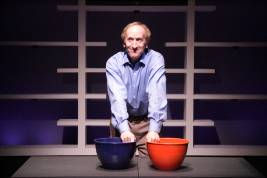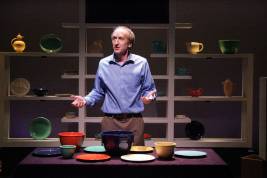
When a self-penned solo performance, the kind that Fringe Festival participants seem ever so fond of, proves so popular that actors other than the original writer get hired to perform it, that’s pretty much a guarantee of something special, or at least this is the case with the Colony Theatre’s latest, Steven Tomlinson’s autobiographical American Fiesta.
 Colony favorite Larry Cedar stars as Steven (or perhaps a somewhat fictionalized version of the writer-performer), a Midwest native who left his tiny Oklahoma hometown in search of greener (or at least more “lifestyle-accepting”) pastures elsewhere.
Colony favorite Larry Cedar stars as Steven (or perhaps a somewhat fictionalized version of the writer-performer), a Midwest native who left his tiny Oklahoma hometown in search of greener (or at least more “lifestyle-accepting”) pastures elsewhere.
When Steven’s life partner Leon proposes that they get married up in Vancouver, the writer’s old-school father flatly refuses to travel to Canada for his son’s same-sex nuptials, and whither Dad will not travel, neither will Mom, though her childhood gifts to young Stevie (Ken doll outfits for the GI Joe action figure that was his father’s gift) reveal a mother’s understanding of and unconditional love for her child, however her “traditional marriage” might force her to side with her spouse.
It’s on a return drive to the home he shares with Leon that Steven notices a roadside shop called “Grandpa’s Attic,” and he stops to check it out.
Entering the shop, a #7 Red Fiestaware bowl catches Steven’s eye and an obsession is born to fill his and Leon’s home with the rainbow hues of the iconic ceramic dinnerware first introduced in 1936.
Just as the possibility of acquiring colorful plates and bowls and cups an affordable one-at-a-time gave hope to Depression-era housewives, the complementary nature of Fiestaware’s mix-and-match hues begins to symbolize for Steven an “American Fiesta” in which Red State conservatives and Blue State progressives can live harmoniously, if not in complete acceptance.
Steven’s Fiestaware obsession quickly makes Ebay his website of choice, and it is there that he discovers that “It’s a plot! The typical transaction is a 60-year-old woman in a Midwestern town selling to an urban bachelor on the coast.” Yes, indeed. Fiestaware is slowly but surely making its way from Red States to Blue!
Other discoveries Steven makes along the way include a realization that the original 1930s Fiestaware colors were the same as the colors on the Department of Homeland Security’s Terror Alert scale and the fascinating factoid that the original Fiestaware is in fact radioactive, though probably not life-threateningly so.
 As Steven’s Fiestaware collection grows, American Fiesta muses on the meaning of marriage in the 21st Century, the nature of parent-child relationships when son or daughter is no longer a child and parents may no longer “know best,” and how in the very same way that opposing Fiestaware colors end up matching quite perfectly, so too do couples as dissimilar as Steven’s parents and as Steven and Leon fit together as perfectly as two pieces of the same puzzle. Steven also discovers to his surprise that the chips and scratches and nicks that he initially rejects in previously owned Fiestaware are precisely what makes them special, and that perhaps perfection is equally unnecessary in parent-child relationships, if only we could learn to eliminate the word “but” from our vocabulary and use in its place the more inclusive “and.”
As Steven’s Fiestaware collection grows, American Fiesta muses on the meaning of marriage in the 21st Century, the nature of parent-child relationships when son or daughter is no longer a child and parents may no longer “know best,” and how in the very same way that opposing Fiestaware colors end up matching quite perfectly, so too do couples as dissimilar as Steven’s parents and as Steven and Leon fit together as perfectly as two pieces of the same puzzle. Steven also discovers to his surprise that the chips and scratches and nicks that he initially rejects in previously owned Fiestaware are precisely what makes them special, and that perhaps perfection is equally unnecessary in parent-child relationships, if only we could learn to eliminate the word “but” from our vocabulary and use in its place the more inclusive “and.”
As personal as Tomlinson’s solo play most certainly is, and as intrinsically “right” for it its author must have been when he starred as himself in its 2007 Off-Broadway debut, the role of “Steven” may actually be better served when portrayed by a trained actor like Cedar, whose Scenie-winning Best Lead Actor performances in the Colony’s Billy Bishop Goes To War and Travels With My Aunt had him playing multiple roles to perfection.
As many as twenty different characters pop up in American Fiesta, most notably Tomlinson’s now-husband Leon (whom Cedar gives a charming South-Of-The-Border accent which the real Leon apparently lacks, but which adds considerably to the character’s appeal), his oh-so different parents, along with assorted shopkeepers, collectors, and others. It matters not a whit that Cedar’s real-life spouse happens to be of the opposite sex. The Steven he creates is so authentically three-dimensional (as are the supporting players in Steven’s life), that we come to embrace them all in Cedar’s gifted hands.
Credit for the above is surely shared with director (and Colony mainstay) David Rose, who has not only helped Cedar mold his many characters but makes visually inventive use of the Colony stage, aided and abetted by Jared A. Sayeg’s fabulous Fiestaware-hued lighting design on scenic designer David Potts’ beautifully conceived set, one which gets slowly but surely filled with properties designers/set decorators MacAndME’s profusion of Fiestaware. Dave Mickey’s expert sound design adds subtly to American Fiesta’s appeal, while costume designer Kate Bergh has given Steven just the kind of shirt and slacks we’d expect him to buy for himself. Mickey and Kristen Campbell have also created a clever, colorful video design, which shows us, among other things, how our brains react to various stimuli, whether political or simply the sight of a new piece of Fiestaware. Brian Cordoba is production stage manager.
American Fiesta’s arrival in this pre-election month is particularly timely, with its optimistic message that as divided as we are, there may indeed be a place for us to meet in the middle. Tomlinson’s script, Rose’s direction, a crackerjack team of designers, and most importantly Cedar’s memorable performance make it a terrific way for opposing sides of the political spectrum to sit side-by-side in the melting pot we call theater.
Colony Theatre, 555 North Third Street, Burbank.
www.colonytheatre.org
–Steven Stanley
September 29, 2012
Photos: Michael Lamont


 Since 2007, Steven Stanley's StageSceneLA.com has spotlighted the best in Southern California theater via reviews, interviews, and its annual StageSceneLA Scenies.
Since 2007, Steven Stanley's StageSceneLA.com has spotlighted the best in Southern California theater via reviews, interviews, and its annual StageSceneLA Scenies.







 COPYRIGHT 2025 STEVEN STANLEY :: DESIGN BY
COPYRIGHT 2025 STEVEN STANLEY :: DESIGN BY